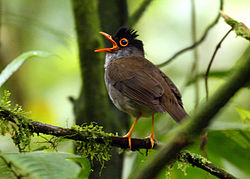| Black-headed nightingale-thrush | |
|---|---|
 | |
| Scientific classification | |
| Kingdom: | Animalia |
| Phylum: | Chordata |
| Class: | Aves |
| Order: | Passeriformes |
| Family: | Turdidae |
| Genus: | Catharus |
| Species: | C. mexicanus |
| Binomial name | |
| Catharus mexicanus (Bonaparte, 1856) | |
 | |
The black-headed nightingale-thrush (Catharus mexicanus) is a species of bird in the family Turdidae. It is found in Costa Rica, Guatemala, Honduras, Mexico, Nicaragua, and Panama.
Its natural habitats are subtropical or tropical moist lowland forest and subtropical or tropical moist montane forest.
When interacting with ruddy-capped nightingale-thrushes, it is aggressive. [2]
